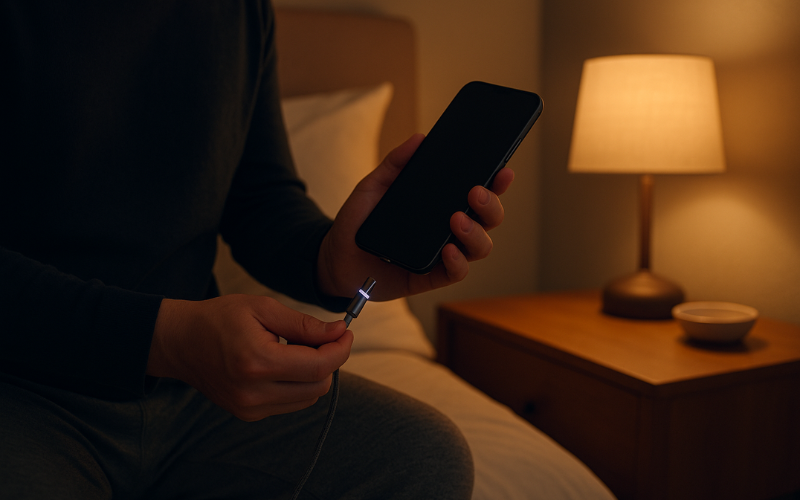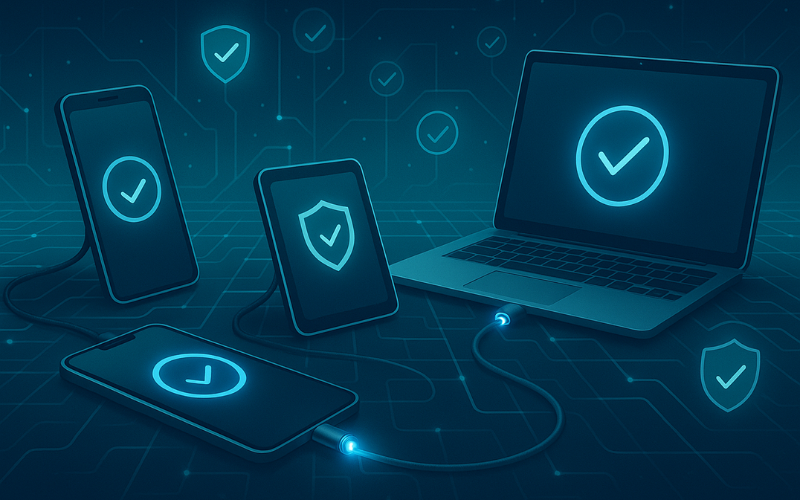What Are Magnetic Charging Cables?
Magnetic charging cables are a newer style of phone and device chargers that use magnetic force to connect the cable to the device. Instead of plugging a connector directly into your phone’s port each time, a small magnetic tip stays in your phone, and the cable clicks into place magnetically.
This setup makes it easier to charge your device with one hand, reduces wear and tear on the charging port, and can even help avoid accidents such as when someone trips over the cable, it detaches instead of pulling the device down.
There are various versions of magnetic chargers available today, including options for USB-C, Lightning, and Micro-USB ports. Some offer fast charging and data transfer support, while others are more basic. But despite the convenience, many users wonder: are they actually safe?
Do Magnetic Charging Cables Damage Your Phone?
In general, high-quality magnetic charging cables do not damage your phone. However, low-quality or cheap versions might pose risks if they:
- Deliver inconsistent power
- Don’t fit snugly and cause port stress
- Interfere with the phone’s internal components
Why damage may occur:
The small magnetic tip can attract metal dust or debris. If not cleaned properly, this can create sparks or even short circuits.
How to stay safe:
- Choose well-reviewed brands
- Clean the tip regularly
- Avoid overcharging with poorly regulated cables
So, while magnetic cables are safe overall, quality and maintenance matter significantly.
Are Magnetic Cables Safe for Fast Charging?
Yes, some magnetic charging cables support fast charging, but not all. Safety depends on compatibility and how well the cable is designed to handle high currents.
| Feature | Safe Magnetic Cables | Unsafe/Low-Quality Ones |
| Fast Charging Support | Yes (PD/QC rated) | Often missing |
| Current Regulation | Stable | Inconsistent |
| Temperature Control | Present | Lacking |
| Certification (CE, FCC) | Usually present | Usually missing |
Important Tip: Always match the charging cable with the correct power adapter. Even a good magnetic cable can become unsafe if used with an incompatible charger.

Can Magnetic Charging Cables Transfer Data?
Many users believe magnetic cables are only for charging, but that’s not entirely true.
Some magnetic cables are fully capable of data transfer, including:
- File sharing between phone and computer
- Syncing with smartwatches or accessories
- Firmware updates
However, not all magnetic cables include data pins. If you want both charging and data functions:
- Look for cables labeled as “Data + Charging”
- Confirm USB standards like USB 2.0/3.0 support
Reminder: A charging-only cable is usually cheaper, but limited in daily use.
Can They Interfere with Phones or Devices?
A common concern is whether the magnetic field interferes with your phone’s components. The good news? The magnets in these cables are not strong enough to affect modern electronics.
That said, there are a few precautions:
- Keep magnetic tips away from credit cards or magnetic key cards
- Avoid letting small metal objects stick to the tip (can cause heating or spark)
- If you use hearing aids or pacemakers, consult your doctor before use
Overall verdict: For most users, magnetic charging cables pose no interference risks.
Pros of Using Magnetic Charging Cables
Magnetic charging cables offer several user-friendly advantages, especially in everyday situations.
Key Benefits:
- Easy to Connect: No need to fumble with tiny ports, especially useful in the dark
- Port Protection: Reduces wear on your phone’s charging port
- Tangle-Free Use: Most magnetic cables have durable, braided designs
- Safe Disconnection: Prevents phone drops when the cable is yanked
Real-world use cases:
- Ideal for kids and elderly users
- Useful in cars where one-hand connection is needed
- Handy at workstations where cables are constantly in use
These features make magnetic chargers a solid convenience upgrade for many users.
Risks and Downsides to Consider
Despite the benefits, magnetic cables aren’t perfect. Understanding their limitations helps you make informed choices.
Potential Risks:
- Loose Connection: Magnets can weaken or misalign over time
- Lower Power Delivery: Some cables don’t support high-wattage charging
- Device Compatibility Issues: Not all devices fit the same magnetic heads
- Metal Debris Attraction: Tips can gather tiny metallic dust, leading to sparks

Tips to Minimize Risks:
- Clean the cable tip weekly
- Store the cable in a dust-free place
- Avoid overly cheap or non-certified brands
So while not dangerous by design, poor usage habits can make them risky.
How to Choose a Safe Magnetic Charging Cable
Choosing the right magnetic cable involves more than just magnet strength. Build quality and certification are crucial.
Must-have Features in a Safe Cable:
- Strong Magnetic Hold: Not too weak, not too tight
- Power Delivery (PD) Support: For fast charging needs
- Data Transfer Support: If needed for syncing
- Overcurrent Protection: Safeguards your phone’s battery
- Heat-Resistant Housing: Avoids melting or warping
Brand Reputation Matters
Stick to brands with:
- High user ratings
- Certifications like CE, RoHS, FCC
- Clear power and data specs
Top Trusted Magnetic Cable Brands:
- Anker
- Baseus
- Mcdodo
- NetDot
Are They Safe or Not?
Yes, magnetic charging cables are safe, if you choose the right one and use it responsibly. They’re especially useful for convenience, port protection, and avoiding cable-related accidents.
But they are not all created equal.
| Safety Factor | Safe Use Tip |
| Cable Quality | Choose certified brands with good reviews |
| Usage Habits | Keep the tip clean and avoid forceful pulls |
| Charging Speed | Match the cable with the correct charger |
| Data Needs | Pick cables with full data transfer support |
If safety and longevity are your priorities, a magnetic cable from a trusted brand can be a reliable charging solution for years to come.
Leave a reply